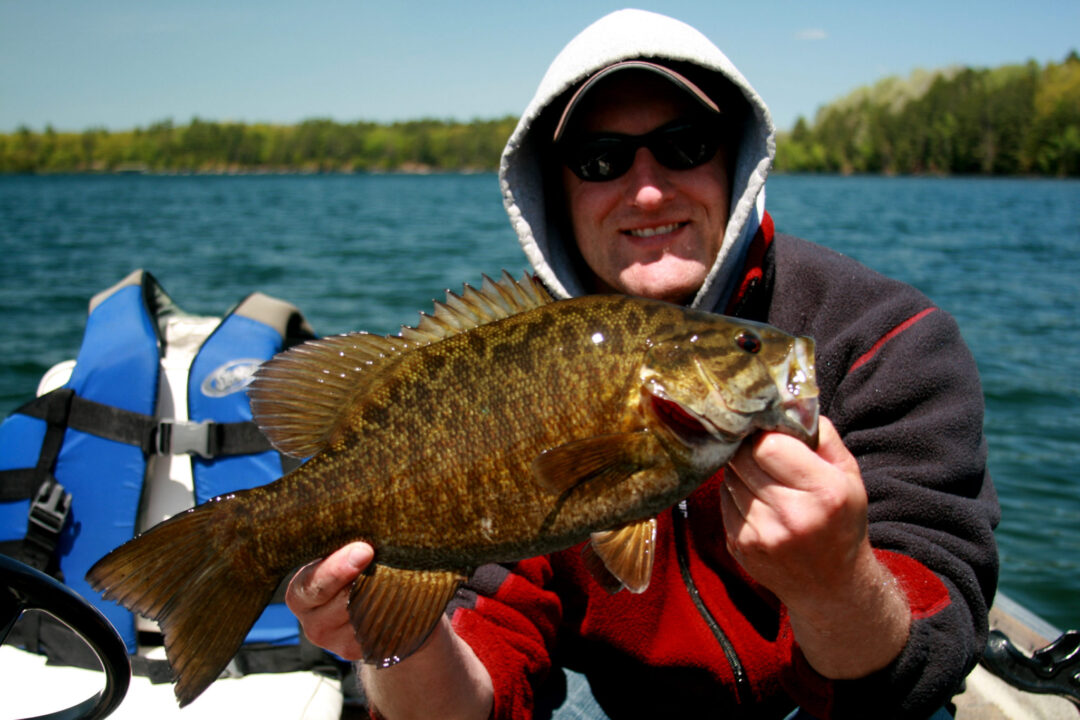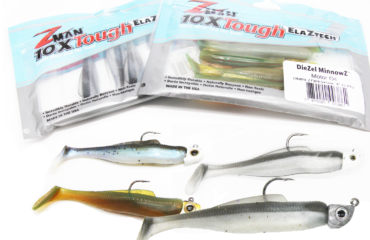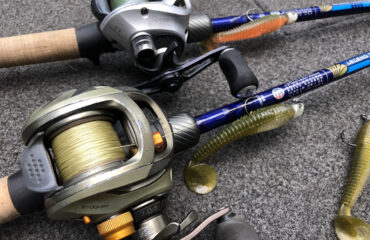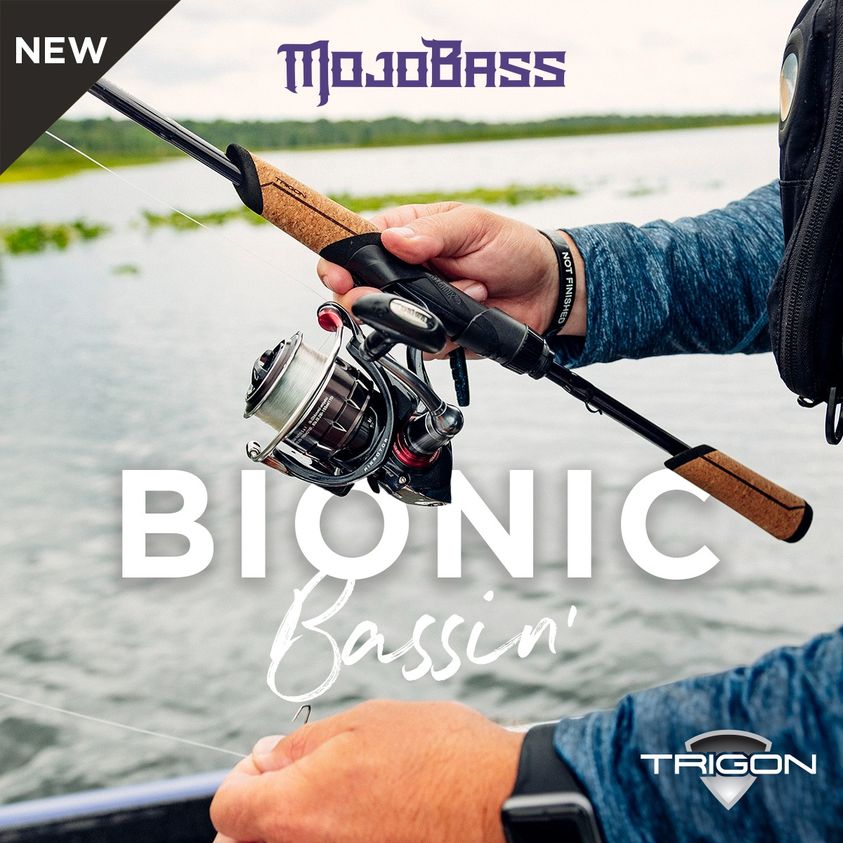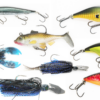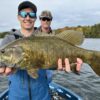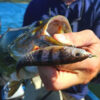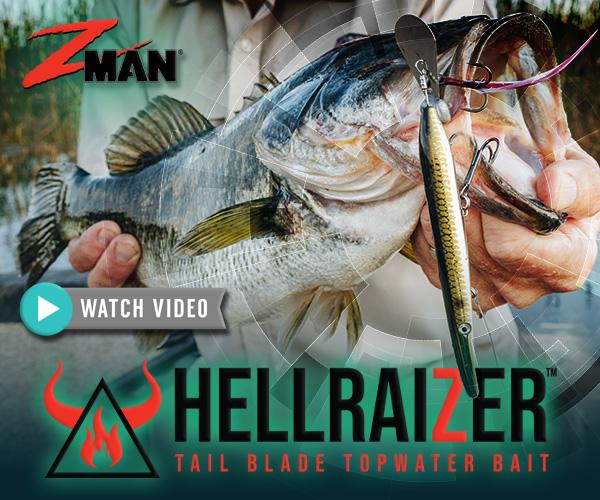Ten Smallmouth Bass Methods for 2013
By Andrew Ragas
If you’ve located the fish, try these ten smallmouth bass methods for 2013. A diversified lure selection will not only make you a more versatile angler, but allow you to catch more fish.
Prime patterns and favorite lures can be revisited each year, especially as the environment and behaviors of smallmouth bass dictate their locations and influence their feeding habits. As readers first open these pages in early May, smallmouth bass throughout the Great Lakes and Upper Midwest regions are anywhere in pre-spawn to spawning mode. Meanwhile, down south or depending on how warm the spring season has been up to this point wherever you live, smallmouth bass could already be entrenched in their summer patterns.
As any observant and scientific-minded angler can conclude, the success you have with your favorite lures and technique-specific methods depends on conditions, locations, and environments. On the lakes and rivers you fish, what are the some of your favorite methods to catch big fish throughout the year? Create the list, put it all together, look at it, and then apply to your situation.
To cover all of the smallmouth bass waters and habitats I fish, my starting lineup features 10 trustworthy lures (in no particular order) for big bass action in any condition, location, and environment.
1 – Tube (fished with jig)
Wildly considered to be the most popular smallmouth bass lure of all time, the tube is versatile to be fished as a representation of the bottom dwelling crawfish and goby or suspending pelagic baitfish. My favorite way to fish the tube is by jig, preferably with an exposed football head, or with a 1/16 oz to 3/8 oz jig insert. In some scenarios such as snags and heavy cover, I may even fish the tube Texas rigged.
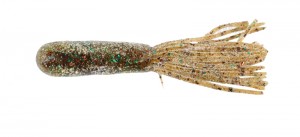
The aisles of tackle shops and storefronts of online stores are inundated with tubes in all shapes, sizes, colors and scent types, and are produced by most major soft plastics brands. I’ve learned that tube selection is dictated by color matching the prey as well as blending in with the environment (ie. dark bottoms suggest dark colored tubes, vice-versa). My favorites to date are Strike King’s Pro Model and Coffee Tubes, and Stankx Bait Company’s D.D. Tubez. Both brands offer numerous color schemes that are the most naturalistic and accurate representations of popular smallmouth fare.
Throughout this year’s fishing season, I encourage you to take the time to observe crayfish behavior and baitfish mannerisms, and it will open up your fishing possibilities with the tube.
2 – Jerkbait (soft & hard)
I classify jerkbaits by two types: Softbait and hardbait. I fish both styles differently depending upon what conditions and feeding moods dictate. I use soft jerkbaits for less aggressive fish (finesse and sight fishing), and hard jerkbaits for active aggressive fish and as a reactionary bait during coldfront and cold water periods.

Soft jerkbaits in the “fluke” style rigged weedless and weightless are my favorites for sight fishing and when fish are in the shallows. I also like to fish them deeper with Carolina rigs and while drift fishing, as well as jigging for suspenders. On rivers, soft jerkbaits shine for their weedless rigging capabilities, enticing action, and baitfish representation. The best soft jerkbait brands I’ve used are Zoom (fluke and super fluke jr), and Trigger-X for their flexibility and lifelike action.

Meanwhile, hardbaits such as the Rapala X-Rap, Husky Jerk, and Matzuo Minnow in both natural and bright fluorescent colors are a year-round staple. I catch smallmouths with such proficiency on hard jerkbaits from ice-out until ice-up, primarily on lakes and reservoirs. In terms of retrieve and lure action, the versatility of a jerkbait is unrivaled as success can be had from a bad reactionary bite to the best feeding frenzy imaginable. Style of retrieve seriously triggers the strike and influences the success of your fishing!
3 – Spinnerbait (anything white, preferably)
The smallmouth spinnerbait is the one in my box that reaches the right depth, is retrieved at the right speed, and pumps out the right amounts of flash and vibration to entice strikes. When the spinnerbait puzzle is properly connected, the reward is big fish. In order for it to work at its best, the spinnerbait must possess the three qualities of speed, vibration, and detail. As a power fisherman, the majority of the smallmouths I catch are victims of reeling with 7.0:1 or greater gear ratio casting reels. I retrieve quickly to cover distance and to impart vibration. With my quick retrieves, the curious, aggressive natured smallmouth bass never gets a clean look at the lure.
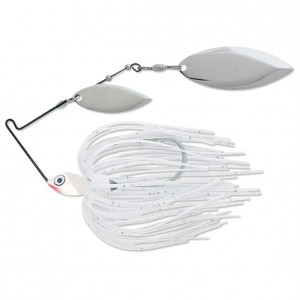
For rivers, I prefer the thump of single or double Colorado, Oklahoma, or Indiana blade. Meanwhile, for lakes I predominantly use willow blades for speed and power. In my opinion, color matters for smallmouths when matching the hatch and dealing with water clarity. I like natural imitations of forage or else the opposite, something gaudy and obnoxious that can be seen from distance. With realism and unnatural colors in mind, it pays to carry a variety of styles, colors, and skirts. I predominantly carry a large supply of assorted 3/8 oz to ½ oz sizes in single Colorado, double Colorado, and willow blade models in all types of color. Favorites are Terminator T2 and Strike King Pro Model. White is a universal color, quite possibly my most popular color selection on every river and lake I fish. Any variation of white seems to stand out well to smallmouth bass.
4 – Crankbait (craw patterned)
Smallmouths love crayfish and no hard bodied artificial lure represents a scurrying crayfish better than a crankbait. All of my cranking for smallmouths takes place in depths shallower than 15 feet, and the technique must always be associated with structure. In order to bang the
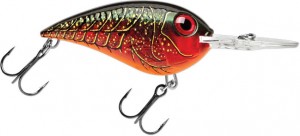
bottom, graze the tops of rocks or burn across the sandbar, a shallow running crankbait such as the Rapala DT 4 and Crankin’ Rap (with rattle chamber) works exceptionally well in the shallows of lakes and all river environments I’ve fished. Meanwhile, the DT 6 and Clackin’ Rap associate best with depths of 5 to 15 feet. Beyond 15 feet, I rarely ever fish crankbaits for smallmouths. When I do, however, I switch to baitfish colors and profiles for obvious reasons. For these cranky smallmouths, the color selection doesn’t get easier than a handful of reds, browns, oranges and yellows.
5 – Jig (for casting and swimming)
My smallmouth jigs are categorized by two types: The standard brushguard jig, and swim jig. Specialty jigs such as these have become popular in recent years for their technique-specific applications and big fish appeal.
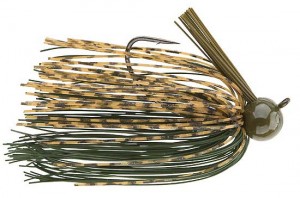 I fish a lot of rock infested lakes and reservoirs. I also wade and float a number of different rivers. Brushguard jigs are available in a variety of weights and a number of different styles. They are primarily designed to represent crayfish. The detail and color schemes of some brands creates a very naturalistic presentation. On lakes I usually fish 1/8 oz to 1/2 oz jigs (Booyah, Terminator) with casting gear. On rivers I predominantly fish smaller profile jigs (Strike King Bitsy Bugs) with spinning gear. Unlike largemouth bass fishing, I’ve learned there is no particular reason for smallmouth anglers to use heavy flipping sticks and gear that is overkill with the jig. For these fish, light line is usually key. It usually imparts greater lure action and sensitivity for successful hook sets.
I fish a lot of rock infested lakes and reservoirs. I also wade and float a number of different rivers. Brushguard jigs are available in a variety of weights and a number of different styles. They are primarily designed to represent crayfish. The detail and color schemes of some brands creates a very naturalistic presentation. On lakes I usually fish 1/8 oz to 1/2 oz jigs (Booyah, Terminator) with casting gear. On rivers I predominantly fish smaller profile jigs (Strike King Bitsy Bugs) with spinning gear. Unlike largemouth bass fishing, I’ve learned there is no particular reason for smallmouth anglers to use heavy flipping sticks and gear that is overkill with the jig. For these fish, light line is usually key. It usually imparts greater lure action and sensitivity for successful hook sets.
Another jig type to consider for smallmouth bass is the swim jig. I’ve only recently added this into my angling portfolio and am still learning how to successfully catch smallmouths with it. Based on the results of good friends and my Heartland Outdoors Magazine colleague, Jonn Graham, who is the swim jig maestro and owner of Warrior Jigs, it is a lure that seemingly catches big bass from every lake and river fished.
6 – Swimming Grub (jig worm)
I learned to catch my first smallmouth bass with the swimming grub and this is a tactic I still heavily rely on for year-round success for not only action, but big fish. Tie on a 3 to 5 inch grub, rig it with your jig head of choice, and cast it out. Instead of allowing the grub to work its way down into the rocks, it’s best fished with a predominant slow swimming retrieve and occasional bottom grazing.
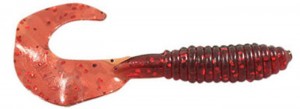 Swimming the grub is a deadly finessed-down search bait, as well as a bait for enticing bites once fish are located. As you move along the shoreline, or cover the entire sand bar or rock flat, it is possible to cover the same amount of water that you would if you were fishing a spinnerbait. But instead, you are using a more subtle presentation.
Swimming the grub is a deadly finessed-down search bait, as well as a bait for enticing bites once fish are located. As you move along the shoreline, or cover the entire sand bar or rock flat, it is possible to cover the same amount of water that you would if you were fishing a spinnerbait. But instead, you are using a more subtle presentation.
With the swimming grub, matching the hatch is critical for success. Be sure the size and appearance of forage (crayfish and baitfish) matches the size of the grub. Make sure the grub is compatible with the water clarity being fished. The simplicity of the swimming grub is what makes it work so well. The action of a curly tail grub such as the Kalins brand is plenty to entice a strike whether you are fishing lakes, rivers, creeks, or any waters inhabited by smallmouth bass.
7 – Drop Shot
Believe it or not, drop shotting is a technique that I seldom use. I’ve made the mistake of stereotyping it as a boring rig that is best used for catching deep suspended fish with your electronics because that’s all I’ve ever used it for.
 However, after watching countless episodes of Dave Mercer’s Facts of Fishing and Jonathan VanDam on various other television shows, I came to the conclusion that the drop shot rig is truly a must-have in every bass angler’s bag of tricks. Unlike that boring vertical concept I was accustomed to using and magnificently failing with, these guys and everyone else I’ve observed fish the drop shot differently. As you would with the concept of “power shotting,” they actually cast it, and slowly retrieve it like an ordinary lure by keeping the dropper weight glued to the bottom.
However, after watching countless episodes of Dave Mercer’s Facts of Fishing and Jonathan VanDam on various other television shows, I came to the conclusion that the drop shot rig is truly a must-have in every bass angler’s bag of tricks. Unlike that boring vertical concept I was accustomed to using and magnificently failing with, these guys and everyone else I’ve observed fish the drop shot differently. As you would with the concept of “power shotting,” they actually cast it, and slowly retrieve it like an ordinary lure by keeping the dropper weight glued to the bottom.
Throughout 2013, the drop shot is one style of fishing I am committed to learning and using. I feel it will work outrageously well during the post-spawn when fish are on their shallow water feeds or in a negative mood. If considering doing the same, I recommend trying the new Strike King Dream Shots, or the Stankx Bait Company DS Slugz and asking owner Travis Crosman to make you any custom color.
8 – Soft Swimbait
Soft swimbaits catch smallmouth bass as well as they do open water largemouth bass. However, I don’t fish my swimbaits for smallies anywhere in or near open water. It’s always done while casting for structure and cover-oriented fish, and during the summertime and fall periods when fish are using the weedlines to ambush perch and other baitfish during their seasonal migrations.
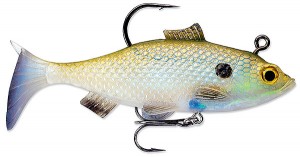 As you may be aware, many swimbaits are expensive, flamboyant, and really unnecessary for bass fishing. Smallmouth bass swimbaits thankfully aren’t. Some of the best swimbaits I’ve used are quite simple, affordable, and very well detailed to represent baitfish and other prey fish. I recommend checking out the Storm WidEye series of swimbaits. They come in packs of three to five in pre-rigged models and accurately represent the real thing. I cannot tell you the amount of smallmouth bass I’ve caught with the shiner and yellow perch colors. Other soft swimbaits worth consideration are the less realistic YUM money minnows which are available with specialized hooks, and the Swankx Swimbait, the newest release from Stankx Bait Company that can be custom poured to match any color and baitfish known to live in the wild.
As you may be aware, many swimbaits are expensive, flamboyant, and really unnecessary for bass fishing. Smallmouth bass swimbaits thankfully aren’t. Some of the best swimbaits I’ve used are quite simple, affordable, and very well detailed to represent baitfish and other prey fish. I recommend checking out the Storm WidEye series of swimbaits. They come in packs of three to five in pre-rigged models and accurately represent the real thing. I cannot tell you the amount of smallmouth bass I’ve caught with the shiner and yellow perch colors. Other soft swimbaits worth consideration are the less realistic YUM money minnows which are available with specialized hooks, and the Swankx Swimbait, the newest release from Stankx Bait Company that can be custom poured to match any color and baitfish known to live in the wild.
9 – Hula Grub
Since 2009, the skirted twin tail grub, regarded as “hula grub,” has put more big smallmouth bass in my boat than anything else besides the X-Rap. Best fished with a weighted weedless hook (around rocks and cover – a must for rivers), or football jig (for deep fish), it is a deadly bait that represents crayfish.
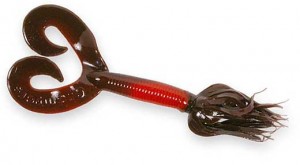 Nowadays, there are a lot of soft plastics brands that produce their own versions of the hula grub. Without question, my favorite is the Chompers skirted twin tail. They run on the expensive side of this lure category, $5.99-$7.99, but are durable, overloaded with scented garlic goodness, and reek so bad that smallmouth laugh at us by how bad they smell to us. Over the winter I learned a new trick from my friend and fellow smallmouth junkie, Johnny Amato. He recommends saving the used and torn up baits, placing them back into the original smelly packaging, and infusing them again with a combination of homemade garlic and coffee extract. He then lets them cook inside the bag for a few weeks. This combination, he says, reinvigorates the busted baits to performing again, regardless of their deformities.
Nowadays, there are a lot of soft plastics brands that produce their own versions of the hula grub. Without question, my favorite is the Chompers skirted twin tail. They run on the expensive side of this lure category, $5.99-$7.99, but are durable, overloaded with scented garlic goodness, and reek so bad that smallmouth laugh at us by how bad they smell to us. Over the winter I learned a new trick from my friend and fellow smallmouth junkie, Johnny Amato. He recommends saving the used and torn up baits, placing them back into the original smelly packaging, and infusing them again with a combination of homemade garlic and coffee extract. He then lets them cook inside the bag for a few weeks. This combination, he says, reinvigorates the busted baits to performing again, regardless of their deformities.
Meanwhile, other successful brands to try are YUM Gonzo Grubs, which are a scaled down version but loaded on salt, and the small local Chicago independent Dragin Bait Company which specializes in custom colors and offer a finesse model.
10 – Live Bait
Most bass anglers will cringe at the concept of fishing with live bait, let alone the thought of ever using it. Putting the ego aside, fishing with live bait is an excellent option for catching smallmouth bass.
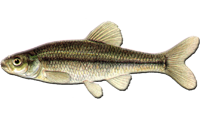 I was introduced to bass fishing at a young age by strictly live bait fishing. Until I learned how to successfully fish with artificial lures, it was the most effective way I’ve ever fished. To this day I still utilize live bait techniques when presented with the right opportunities for them. Fishing with live bait and the success that can be had with it isn’t a secret. When the fishing becomes difficult during the cold water period anglers frequently turn to jigging and rigging for bass with live minnows such as redtail chubs and juvenile perch (where legal). Likewise, live bait such as a whole nightcrawler or big jumbo leech can be the big ticket to warm water glory.
I was introduced to bass fishing at a young age by strictly live bait fishing. Until I learned how to successfully fish with artificial lures, it was the most effective way I’ve ever fished. To this day I still utilize live bait techniques when presented with the right opportunities for them. Fishing with live bait and the success that can be had with it isn’t a secret. When the fishing becomes difficult during the cold water period anglers frequently turn to jigging and rigging for bass with live minnows such as redtail chubs and juvenile perch (where legal). Likewise, live bait such as a whole nightcrawler or big jumbo leech can be the big ticket to warm water glory.
When bass are active participants during the toughest of conditions and are still interested in feeding, fishing with live bait on either a jig, slip bobber rig, or livebait rig can be a very exciting and refreshing break from fast paced lures and the ‘run and gun’ mentality that most serious bass anglers have. With the different options of using naturally-caught and trapped prey fish, or store-bought bait fish, matching the hatch has never been as easy like this for catching smallmouth bass.
Understanding the characteristics of lures and the physics of why they work the way they do requires observation, experimentation, and time on the water. The task of understanding fish behavior allows us to locate the presentation and refine it with proper techniques and specific lures like these in order to cater to the needs of the fish. For serious smallmouth anglers, finding the right lineup and diversified combination of lures is purely a process of elimination. Before finally matching the right lures to the right spots and location of fish, periods of unproductive fishing may be experienced. But you will be a better bass angler for it. A diversified lure selection will not only make you a more versatile angler, but will allow you to catch more fish season after season.


